Learning How To Code Neural Networks
原文:https://medium.com/learning-new-stuff/how-to-learn-neural-networks-758b78f2736e#.ly5wpz44d
This is the second post in a series of me trying to learn something new over a short period of time. The first time consisted of learning how to do machine learning in a week.
This time I’ve tried to learn neural networks. While I didn’t manage to do it within a week, due to various reasons, I did get a basic understanding of it throughout the summer and autumn of 2015.
By basic understanding, I mean that I finally know how to code simple neural networks from scratch on my own.
In this post, I’ll give a few explanations and guide you to the resources I’ve used, in case you’re interested in doing this yourself.
Step 1: Neurons and forward propagation
So what is a neural network? Let’s wait with the network part and start off with one single neuron.
A neuron is like a function; it takes a few inputs and calculates an output.
The circle below illustrates an artificial neuron. Its input is 5 and its output is 1. The input is the sum of the three synapses connecting to the neuron (the three arrows at the left).
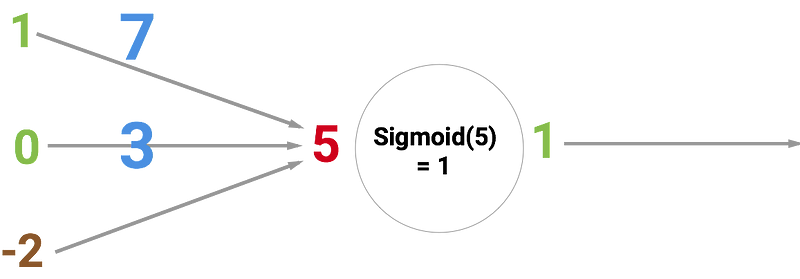
At the far left we see two input values plus a bias value. The input values are 1 and 0 (the green numbers), while the bias holds a value of -2 (the brown number).
The inputs here might be numerical representations of two different features. If we’re building a spam filter, it could be wether or not the email contains more than one CAPITALIZED WORD and wether or not it contains the word ‘viagra’.
The two inputs are then multiplied by their so called weights, which are 7 and 3 (the blue numbers).
Finally we add it up with the bias and end up with a number, in this case: 5 (the red number). This is the input for our artificial neuron.
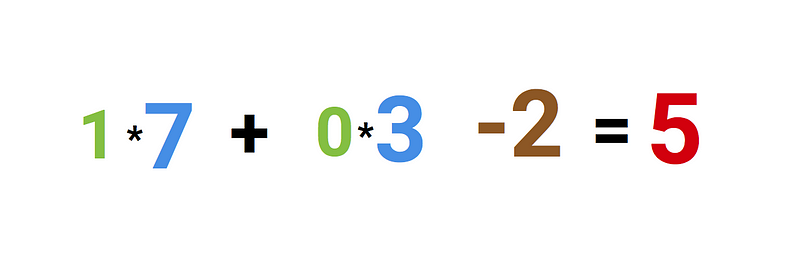
The neuron then performs some kind of computation on this number — in our case the Sigmoid function, and then spits out an output. This happens to be 1, as Sigmoid of 5 equals to 1, if we round the number up (more info on the Sigmoid function follows later).
If this was a spam filter, the fact that we’re outputting 1 (as opposed to 0) probably means that the neuron has labeled the text as ‘spam’.
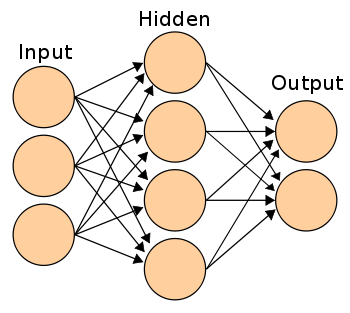
A neural network illustration from Wikipedia.
If you connect a network of these neurons together, you have a neural network, which propagates forward — from input output, via neurons which are connected to each other through synapses, like on the image to the left.
I can strongly recommend theWelch Labs videos on YouTube for getting a better intuitive explanation of this process.
Step 2: Understanding the Sigmoid function
After you’ve seen the Welch Labs videos, its a good idea to spend some time watching Week 4 of the Coursera’s Machine Learning course, which covers neural networks, as it’ll give you more intuition of how they work.
The course is fairly mathematical, and its based around Octave, while I prefer Python. Because of this, I did not do the programming exercises. Instead, I used the videos to help me understand what I needed to learn.
The first thing I realized I needed to investigate further was the Sigmoid function, as this seemed to be a critical part of many neural networks. I knew a little bit about the function, as it was also covered in Week 3 of the same course. So I went back and watched these videos again.
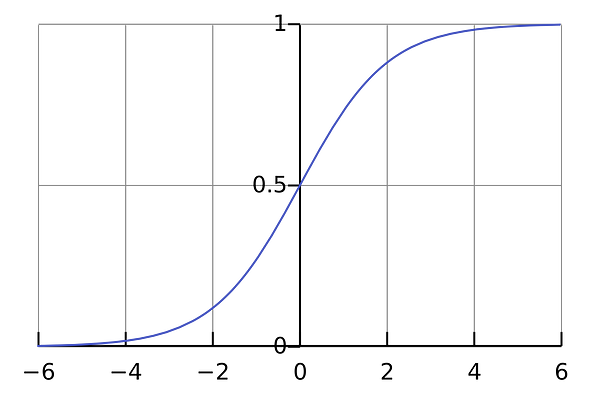
The Sigmoid function simply maps your value (along the horizontal axis) to a value between 0 and 1.
But watching videos won’t get you all the way. To really understand it, I felt I needed to code it from the ground up.
So I started to code a logistic regression algorithm from scratch (which happened to use the Sigmoid function).
It took a whole day, and it’s probably not a very good implementation of logistic regression. But that doesn’t matter, as I finally understood how it works. Check the code here.
You don’t need to perform this entire exercise yourself, as it requires some knowledge about and cost functions and gradient descent, which you might not have at this point.
But make sure you understand how the Sigmoid function works.
Step 3: Understanding backpropagation
Understanding how a neural network works from input to output isn’t that difficult to understand, at least conceptually.
More difficult though, is understanding how the neural network actually learns from looking at a set of data samples.
The concept is called backpropagation.
This essentially means that you look at how wrong the network guessed, and then adjust the networks weights accordingly.
The weights were the blue numbers on our neuron in the beginning of the article.
This process happens backwards, because you start at the end of the network (observe how wrong the networks ‘guess’ is), and then move backwards through the network, while adjusting the weights on the way, until you finally reach the inputs.
To calculate this by hand requires some calculus, as it involves getting some derivatives of the networks’ weights. The Kahn Academy calculus courses seems like a good way to start, though I haven’t used them myself, as I took calculus on university.
Note: there are a lot of libraries that calculates the derivatives for you, so if you’d like to start coding neural networks before completely understanding the math, you’re fully able to do this as well.
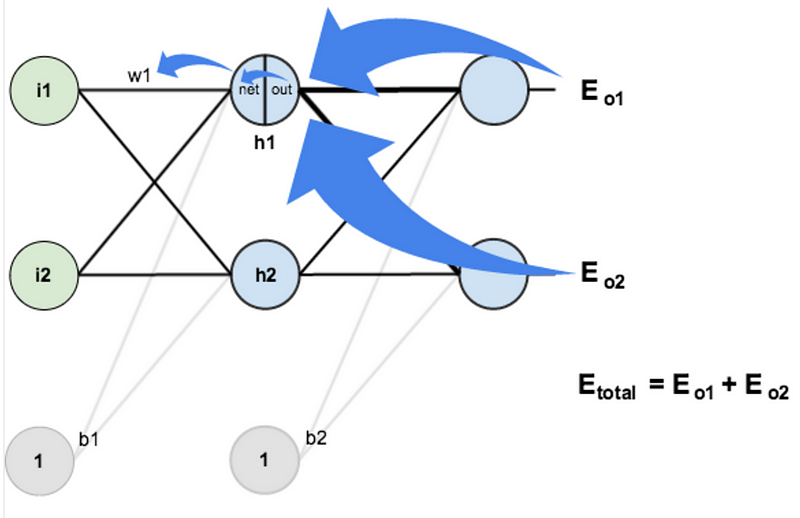
Screehshot from Matt Mazurstutorial on backpropagation.
The three best sources I found for understanding backpropagation are these:
- A Step by Step Backpropagation Example — by Matt Mazur
- Hackers Guide to Neural Nets —by Andrej Karpathy
- NeuralNetworksAndDeepLarning — by Michael Nielsen
You should definitely code along while you’re reading the articles, especially the two first ones. It’ll give you some sample code to look back at when you’re confused in the future.
Plus, I can’t really emphasize this enough:
You don’t learn much by reading about neural nets, you need to practice it to make the knowledge stick.
The third article is also fantastic, but I’ve used this more as a wiki than a plain tutorial, as it’s actually an entire book. It contains thorough explanations all the important concepts in neural networks.
These articles will also help you understand important concepts as cost functions and gradient descent, which play equally important roles in neural networks.
Step 4: Coding your own neural networks
In some articles and tutorials you’ll actually end up coding small neural networks. As soon as you’re comfortable with that, I recommend you to go all in on this strategy. It’s both fun and an extremely effective way of learning.
One of the articles I also learned a lot from was A Neural Network in 11 Lines Of Python by IAmTrask. It contains an extraordinary amount of compressed knowledge and concepts in just 11 lines.
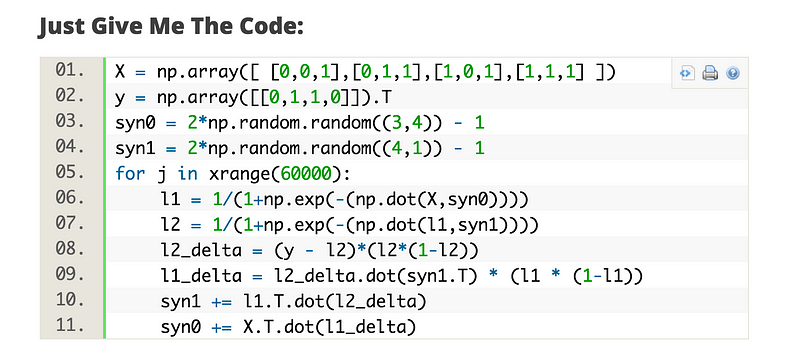
Screenshot from the IAmTrask tutorial
After you’ve coded along with this example, you should do as the article states at the bottom, which is to implement it once again without looking at the tutorial. This forces you to really understand the concepts, and will likely reveal holes in your knowledge, which isn’t fun. However, when you finally manage it, you’ll feel like you’ve just acquired a new superpower.
A little side note: When doing exercises I was often confused by the vectorized implementations some tutorials use, as it requires a little bit of linear algebra to understand. Once again, I turned myself back to the Coursera ML course, as Week 1 contains a full section of linear algebra review. This helps you to understand how matrixes and vectors are multiplied in the networks.
When you’ve done this, you can continue with this Wild ML tutorial, by Denny Britz, which guides you through a little more robust neural network.

Screenshot from the WildML tutorial.
At this point, you could either try and code your own neural network from scratch or start playing around with some of the networks you have coded up already. It’s great fun to find a dataset that interests you and try to make some predictions with your neural nets.
To get a hold of a dataset, just visit my side project Datasets.co (← shameless self promotion) and find one you like.

Visit Datasets.co to get hold of a dataset
Anyway, the point is that you’re now better off experimenting with stuff that interests you rather than following my advices.
Personally, I’m currently learning how to use Python libraries that makes it easier to code up neural networks, like Theano, Lasagne and nolearn. I’m using this to do challenges on Kaggle, which is both great fun and great learning.
Good luck!
And don’t forget to press the heart button if you liked the article :)
Learning How To Code Neural Networks的更多相关文章
- 1506.01186-Cyclical Learning Rates for Training Neural Networks
1506.01186-Cyclical Learning Rates for Training Neural Networks 论文中提出了一种循环调整学习率来训练模型的方式. 如下图: 通过循环的线 ...
- Coursera Deep Learning 2 Improving Deep Neural Networks: Hyperparameter tuning, Regularization and Optimization - week2, Assignment(Optimization Methods)
声明:所有内容来自coursera,作为个人学习笔记记录在这里. 请不要ctrl+c/ctrl+v作业. Optimization Methods Until now, you've always u ...
- Coursera Deep Learning 2 Improving Deep Neural Networks: Hyperparameter tuning, Regularization and Optimization - week1, Assignment(Initialization)
声明:所有内容来自coursera,作为个人学习笔记记录在这里. Initialization Welcome to the first assignment of "Improving D ...
- 吴恩达《深度学习》-课后测验-第一门课 (Neural Networks and Deep Learning)-Week 3 - Shallow Neural Networks(第三周测验 - 浅层神 经网络)
Week 3 Quiz - Shallow Neural Networks(第三周测验 - 浅层神经网络) \1. Which of the following are true? (Check al ...
- Coursera Deep Learning 2 Improving Deep Neural Networks: Hyperparameter tuning, Regularization and Optimization - week1, Assignment(Gradient Checking)
声明:所有内容来自coursera,作为个人学习笔记记录在这里. Gradient Checking Welcome to the final assignment for this week! In ...
- Coursera Deep Learning 2 Improving Deep Neural Networks: Hyperparameter tuning, Regularization and Optimization - week1, Assignment(Regularization)
声明:所有内容来自coursera,作为个人学习笔记记录在这里. Regularization Welcome to the second assignment of this week. Deep ...
- Coursera, Deep Learning 2, Improving Deep Neural Networks: Hyperparameter tuning, Regularization and Optimization - week1, Course
Train/Dev/Test set Bias/Variance Regularization 有下面一些regularization的方法. L2 regularation drop out da ...
- Coursera Deep Learning 2 Improving Deep Neural Networks: Hyperparameter tuning, Regularization and Optimization - week3, Hyperparameter tuning, Batch Normalization and Programming Frameworks
Tuning process 下图中的需要tune的parameter的先后顺序, 红色>黄色>紫色,其他基本不会tune. 先讲到怎么选hyperparameter, 需要随机选取(sa ...
- Coursera Deep Learning 2 Improving Deep Neural Networks: Hyperparameter tuning, Regularization and Optimization - week2, Optimization algorithms
Gradient descent Batch Gradient Decent, Mini-batch gradient descent, Stochastic gradient descent 还有很 ...
随机推荐
- 希尔排序之C++实现(高级版)
希尔排序之C++实现(高级版) 一.源代码:ShellSortHigh.cpp /*希尔排序基本思想: 先取一个小于n的整数d1作为第一个增量,把文件的全部记录分组. 所有距离为d1的倍数的记录放在同 ...
- [BZOJ5291][BJOI2018]链上二次求和(线段树)
感觉自己做的麻烦了,但常数似乎不算差.(只是Luogu最慢的点不到2s本地要跑10+s) 感觉我的想法是最自然的,但不明白为什么网上似乎找不到这种做法.(不过当然所有的做法都是分类大讨论,而我的方法手 ...
- BlocksKit(1)-基本类型的分类
BlocksKit(1)-基本类型的分类 BlocksKit是一个用block的方式来解决我们日常用对集合对象遍历.对象快速生成使用.block作为委托对象的一种综合便利封装库.这个库主要分三个大块C ...
- 解耦你的HTML,CSS和JAVASRIPT
注:本文为翻译文章,原文<Decoupling Your HTML, CSS, and JavaScript> 今天在web上任何大一点的网站或应用程序都包含大量的html,css和jav ...
- 【HDU】2866:Special Prime【数论】
Special Prime Time Limit: 2000/1000 MS (Java/Others) Memory Limit: 32768/32768 K (Java/Others)Tot ...
- BZOJ2716 KD-Tree
好久没写博客了 回去赶了好久文化课 颓欲见长 突然翻到fc爷的KD-Tree板子 来切了到裸题 对于一开始的数据我们可以先预处理 具体的排序方式见板子 其实就是我们对每次选定的一块选一个维度来排序啦 ...
- 关于clipboard插件的使用问题
概述: clipboard.js是一款轻量级的实现复制文本到剪贴板功能的JavaScript插件.通过该插件可以将输入框,文本域,DIV元素中的文本等文本内容复制到剪贴板中 clipboard.js ...
- Python学习笔记(七)—字典的学习
总结内容: 1.字典的定义 2.字典的好处 3.字典的增删改查 4.字典常用方法及内置函数 5.字典的多层嵌套 6.字典的循环 7.字典小练习 1.字典的定义 字典是另一种可变容器模型,且可存储任意类 ...
- "Blessing of Dimisionality: High Dimensional Feature and Its Efficient Compression for Face Verification"学习笔记
这\(^{[1]}\)是一篇关于如何使用高维度特征在人脸验证中的文章,作者以主要LBP为例子,论述了高维特征和验证性能存在着正相关的关系,即人脸维度越高,验证的准确度就越高.由于那时候没有用DeepL ...
- SlickOne敏捷开发框架介绍(一) -- 基于Dapper, Mvc和WebAPI 的快速开发框架
前言:在两年前(最初发布时间:2013年1月9日(csdn),当前文章时间2015年11月10日),项目组推出了基于Dapper,Mvc和WebApi的快速开发框架,随着后续Slickflow产品的实 ...
